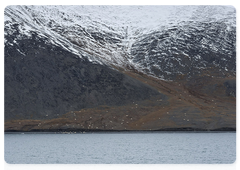MULTIMEDIA
 +
+
From a distance the white spots on the slope of Thomas Mountain looked like sheep on a pasture. Books say that the polar bear is a lone predator that travels all its life on the vast floating Arctic ice, and so it is difficult to imagine a herd of polar bears. However, in certain conditions it is their usual behaviour. It is understandable only when the social life of polar bears is carefully studied and their life in the wild observed without breaking the regular activities of the animals
 +
+
Congregations (behaviorally structured communities) of polar bears near a large food source are neither unique nor common. They have been seen before. Small congregations can be seen even on the ice. However, such a high concentration of polar bears in a relatively small area requires special environmental conditions
 +
+
When the sea ice on the continental shelf area in the Bering sector melts polar bears of both genders and all age groups from the local geographic population unite on Wrangel Island. A bowhead whale’s carcass has united everyone: lone males and females, adults and youngsters, lone bears and families. A family group with four cubs born this year can be seen in the right part of the picture, one of which is adopted (see the article)
 +
+
Four areas can be singled out in the congregation around the whale’s body. The first one is about 20 square metres, and consists of the bears feeding on the carcass (bears at the “feast table”): they are very close to each other, and some of them make physical contact. This area is defined by the size of the part of the carcass, which is situated above the water. The second one is a waiting line, a semi-circle of about 30-metre radius covering about 1,500 square metres on the coast. Here the concentration of animals is high; the average distance is about 7–10 metres. The third one is a recreation area, a semi-circle with about 30 to 250-metre radius covering 96,000 square metres. The fourth zone, the adjacent tundra and the coast line covers some 5 square kilometers at a 250 metre to 10 kilometre distance from the carcass. Bears in this area keep 400 metres or more from each other. This spatial organisation reflects the specifics of social and feeding behaviour of polar bears
 +
+
Polar bears in the recreation and digestion zone. Having eaten, the animals move from the common feast and lie down for a rest. Many bears in this zone clearly stand near each other. Not only family groups (mothers with cubs) keep together. Polar bears have a complicated social organisation with regular alliances among males, complex family groups, alliances between growing bears and different family groups
 +
+
The highest concentration of bears is on the carcass and close to it. When they share a sea mammal’s carcass (a whale or a seal), polar bears feed near each other, some of them in close physical contact. This is a great illustration of the fact that polar bears are very socially advanced. No other species in the Ursidae bear family is able to behave like that. A small fight between two family groups next to the feeding bears scales down to demonstrations that do not hurt animals and result in the approach line, as can be seen in the next image
 +
+
Regulating the approach order when feeding from the same carcass is ritual for polar bears, in that sense that short fights may arise as bears position themselves for certain place near the body or a certain piece of the carcass, but do not forbid others to approach to the food source
 +
+
The subcutaneous fat is the most prized piece of any sea mammal’s carcass. First of all bears eat by slowly turning the skin inside out. An adult, seemingly old and still thin male bear, is standing on the whale body to the left. A bowhead whale’s body that has washed ashore is a chance for all the bears in this congregation to improve their physical shape before the polar winter
 +
+
Polar bears begin to open a whale’s or seal’s carcass at the most easily accessed spots, where there is damage or natural holes. However, when there is not enough space for everyone, bears have to try it from different sides
 +
+
This picture is a good illustration of how socially tolerant polar bears are to each other during their collective consumption and show no signs of sex or age discrimination. In the left part of the picture an adult female bear is standing calmly between two adult male, very close to them
 +
+
The bowhead whale’s carcass is a true gift for polar bears during the melting ice season on Wrangel Island. Such a large amount of food will help the bears wait for the return of the ice, and hence, the beginning of the hunting season, without losses, and will even improve their physical shape before the polar winter
 +
+
A family group with four cubs. It can be seen that one cub (the one right behind its mother) is larger than the others. During the observations it was evident that he usually kept himself more alert and reacted to the mother’s actions with more caution





 ABOUT THE PROGRAMME
ABOUT THE PROGRAMME
 POLAR BEAR RESEARCH: A HISTORY
POLAR BEAR RESEARCH: A HISTORY
 POLAR BEAR: LIFE, BEHAVIOUR AND MORE
POLAR BEAR: LIFE, BEHAVIOUR AND MORE
 VLADIMIR PUTIN'S VISIT
VLADIMIR PUTIN'S VISIT
 NEWS
NEWS
 MULTIMEDIA
MULTIMEDIA